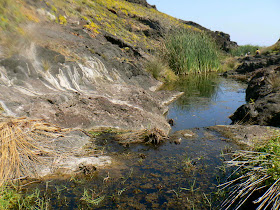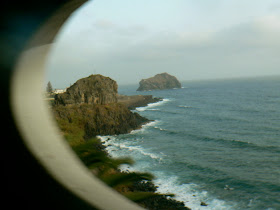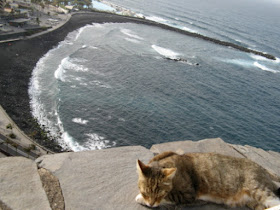Despre primul meu 6.000-miar
 1st day: Bucharest – Paris – Amsterdam – Quito (short transit in Curaçao and Guayaquil).
1st day: Bucharest – Paris – Amsterdam – Quito (short transit in Curaçao and Guayaquil).
2nd day: Quito – Otavalo
Landing in Quito (2.850 m), Ecuadorian Capital City. Drive to Otavalo, by bus, about 2-3 hours. In the afternoon, soft walk to the Peguche Waterfall.
3rd day: Otavalo – Cotacachi – back to Otavalo
Relaxed acclimatisation hike for about 4 hours around La Laguna Cuicocha (3.000 m). Panorama view over San Pablo Lake.
4th day: Otavalo – Imbabura (3.889 m) – back to Otavalo
By bus to the feet of the Volcano Cerro Imbabura. Acclimatisation hike from 3.200 m up to 3.889 m.
5th day (11.09.2001): Otavalo – Fuya-Fuya (4.200 m) – Quito
By bus to the Laguna de Mojanda. Acclimatisation hike for about 4 hours up to the Fuya-Fuya Peak (4.200 m). Back to the hotel in Otavalo and further by bus to Quito.
6th day: Quito – La Hacienda „El Porvenir” (3.600 m)
Leaving Quito by bus, in the morning, entering the Cotopaxi National Park. La Hacienda is very close to the Volcano Ruminahui (4.600 m). Briefing into climbing techniques.
7th day: „El Porvenir” – Volcano Ruminahui (4.700 m)
Start at 8 a.m., reaching the Top of Volcano Ruminahui. Panorama over Lasso and Latacunga Valleys.
8th day: „El Porvenir” – Laguna Limpiopungo (3.800 m)
After about 7 hours of march, we reached a place for spending our next night in tents. The Volcano Cotopaxi hide itself in the very low and dense fog. Very quiet around.
9th day: Laguna Limpiopungo – Cotopaxi high altitude shelter Jose Rivas (4.800 m)
Reaching 4.500 m by bus. From here to the shelter we walked a very steep way, for about one hour, carrying our big packpack.
Briefing into various techniques of ice climbing, glacier descent, security and falling tipps.
10th day: On the Cotopaxi Glacier today up to 5.000 m, exercising the specific techniques.
We started at midnight for ascending the Cotopaxi (5.897 m). At no later than 7 a.m. we have to reach the crater on the top of the highest active vulcano in the world. The descent takes about 3 hours.
11th day: Jose Rivas Shelter – El Banos (1.800 m)
After a night trail of about 12 hours, we reached the shelter again, descended to 4.500 m and from there were driven to El Banos for a warn, quiet, extraordinary relaxing day. From the high mountains here, warm strong waterfalls are descending the green versants.
12th day: El Banos – Waterfall El Diablo – El Banos – Riobamba (2.754 m)
Today in the morning we rent a mountain bike a rode along the Waterfalls Boulevard along the Amazon River to the biggest Waterfall in Ecuador: El Diablo. Adventurous day on our own.
At 3 p.m. we had to be in Banos again and from here, by bus, we reached Riobamba, the capital of the Chimborazo Province in central Ecuador, which is located at the Chambo River Valley of the Andes.It is 200 km south of Ecuador's capital Quito and located at 2.754 m on the Avenue of the Volcanoes.
13th day: Riobamba – La Hacienda “La Releche” (3.700 m), Sangay National Park
In the morning, reaching by bus La Hacienda “La Releche”, then acclimatization hike for about 4 hours. Collanes Valley.
14th day: “La Releche” – Laguna Amarilla (4.200 m)
About 5 hours of trek to the Laguna Amarilla, glacier lake at the feet of the impressive wild Glacier El Altar. Base camp in tents.
15th day: Base camp at 4.000 m – back to “La Releche” – further by bus to Riobamba.
16th day: Riobamba – Andean Open Train to Alausi and Devil’s Nose.
At 6 a.m. we are on the train. A spectacular trail for 7 hours along the Western Cordillera, crossing the Valley named “Nariz del Diablo”. From Alausi returning to Riobamba by bus.
17th day: Riobamba – “Edward Whimper” Shelter (5.000 m)
By bus to 4.800 m, then soft trek for about 45 minutes to the highest shelter in the world.
We started at midnight for ascending the Chimborazo Glacier-Volcano (6.310 m), the highest peak in Ecuador. No later than 6 a.m. we had to reach the point of 6.000 m, to take a short rest and then further into the icy world.
With a peak elevation of 6,310 metres, Chimborazo is the highest mountain in Ecuador.
It is the highest peak in close proximity to the equator.
While Chimborazo is not the highest mountain by elevation above sea level, its location along the equatorial bulge makes its summit the farthest point on the Earth's surface from the Earth's center. The descent takes about 4 hours.
18th day: From 6.300 m back down to „Edward Whimper” Shelter, descending to 4.500 m and further by bus to Quito.
19th day: Free program in Quito, farewell dinner.
21st day: Returning flight Quito – Paris – Bucharest (22nd day)
P.S.
 Those times - Sept. 2001 - I had no digital camera. The about 500 pictures I took there are printed in an album. I put here some pictures I found on Internet and which I recognized as being the places where I personally was.
Those times - Sept. 2001 - I had no digital camera. The about 500 pictures I took there are printed in an album. I put here some pictures I found on Internet and which I recognized as being the places where I personally was.










































































